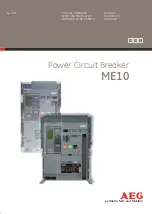
Instruction Book
Effective: March 2007
Page 29
IB6513C80G
For more information visit:
www.EatonElectrical.com
To engage the secondary contacts on the 5kV. design
while the breaker is in the test position, lift the handle on
the front left hand side of the breaker chassis to a
horizontal position. Once the rod is pointing straight out
from the breaker, push it manually to the rear until the
secondaries are initially engaged. At this point, the small
horizontal pin in the handle will have engaged two slots
in the lever, which is pivoted immediately above the
handle. To insure complete secondary engagement,
push down firmly on the curved end of the lever as far
as it will go, using a foot or hand (Figure
4-11
).
When
using a foot, care should be taken not to bend the lever
by using excessive force.
To engage the secondary contacts on the 7.5 or 15kV.
design while the breaker is in the test position, unlatch
the secondary operating rod, and move it to the left until
it points straight out from the breaker. Push the rod
manually to the rear until the secondaries are initially
engaged. Once initial engagement is achieved, hold the
operating rod firmly in that position with one hand, while
grasping the secondary engaging handle with the other
hand. The secondary engaging handle is located to the
right of the operating rod, just inside a rectangular hole.
By pulling firmly on the engaging handle, complete
secondary engagement will be insured (Figure
4-12
)
.
5-4 INTERLOCKS
WARNING
NEVER DISABLE OR DEFEAT ANY INTERLOCKS.
HAZARDOUS VOLTAGES WILL CAUSE DEATH,
SEVERE PERSONAL INJURY OR PROPERTY DAM-
AGE.
All DHP-VR breakers are equipped with interlocks that
are compatible with the existing DHP assembly structure.
These interlocks will insure proper and safe breaker
operation.
5-4.1 BREAKER-CELL CODING PLATES
This is a combination of a notched plate in the cell and
interference bars on the breaker, so that only
appropriately rated breakers can be put into the cell
(Figures
5-10
and
5-11
).
5-4.2 LEVERING-IN INTERLOCK
The levering-in interlock is designed to prevent moving
the breaker into or out of the Operating position, if the
Figure 5-8 Male Secondary Contact Block (In Extended
Position) On 5 kV DHP-VR Breaker
Figure 5-9 Male Secondary Contact Block (In Extended
Position) On 15 kV DHP-VR Breaker











































